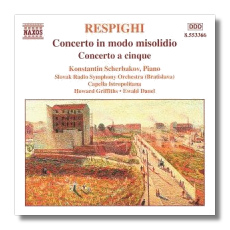
The Internet's Premier Classical Music Source
Related Links
- Respighi Reviews
- Latest Reviews
- More Reviews
-
By Composer
-
Collections
DVD & Blu-ray
Books
Concert Reviews
Articles/Interviews
Software
Audio
Search Amazon
Recommended Links
Site News
 CD Review
CD Review
Ottorino Respighi

Concertos
- Concerto in modo misolidio
- Concerto a cinque *
Konstantin Scherbakov, piano
* Igor Fábera, oboe
* Jurjaz Bartoš, trumpet
* Jarolin Ružička, violin
* Radoslav Šaslina, double bass
Slovak Radio Symphony (Bratislava)/Howard Griffiths
* Capella Istropolitana/Ewald Daniel
Naxos 8.553366 61:02
Summary for the Busy Executive: The other Respighi.
Listeners know Respighi best for his blockbuster Roman trilogy of tone poems – Fountains of Rome, Pines of Rome, and Roman Festivals – all written within roughly a decade (and, by the way, attracting a fan in Mussolini), and for his arrangements of Renaissance lute and keyboard works, collected mainly in his three Ancient Airs and Dances suites. All of these works represent a search for a renewed Italian music, particularly instrumental music, modern yet rooted in the Italian past.
Unfortunately, Respighi's work, despite its enormous attractions, hasn't quite the strength to take on the responsibilities he puts on it. However, Respighi began to explore Gregorian chant as basic material around the end of World War I. Earlier works, even juvenilia, had quoted chant, but a little like tourists with a phrasebook. In the later scores, Respighi makes a new language, based heavily on chant, the music becomes more abstract and the rhetoric deeper. Although it lacks the colorful thrills of the composer's most popular works, this music comes closest to Respighi's ambitions.
From 1925, the three-movement Concerto in modo misolidio for piano and orchestra was designed for Respighi's own abilities at the keyboard. As a pianist, the composer was a good string player. Consequently, this is no virtuoso showcase. The interest of the work comes down to the quality and working-out of ideas, rather than on feats of digital derring-do. The number of movements may be standard, but not the movements themselves. The first takes four ideas – the plainchant Viri Galilaei, an "oriental" arabesque, a descending fanfare, and a lilting ascending theme, which Respighi sometimes treats in canon. It moves along sturdily enough until the end and then falls apart at the third (!) cadenza, although the composer manages to pull it together for a poetic close. The slow movement, marked Lento, my favorite of the concerto, begins with a beautiful modal theme in the strings. For the first few minutes, the piano confines itself to essentially embroidery, while the orchestra takes the burden of the argument. The piano then begins a more equal dialogue with the orchestra, which leads to a noble chorale idea in the brass, against which the piano comments. Eventually, we encounter a "pastoral" duet between oboe and bassoon against radiant strings. Again, the piano confines itself to comment. A variant of the initial idea returns, with piano again in subsidiary role. The orchestra drops out, the piano strikes up something new and sprightlier, and we find ourselves in the finale, which Respighi designates as a passacaglia. It lies squarely in the Romantic tradition of homage to the Baroque (see Brahms' Haydn Variations, for example), rather than any Stravinskian pastiche or Hindemithian homage. It's far from a strict example of the form, and indeed the subject, with an insistence on the tonic note, is not all that promising. "Passacaglia-inspired" rather than a true passacaglia hits closer to the mark, but it bubbles with so much inventive music, I don't complain.
The Concerto a cinque represents Respighi's rapprochement with international neoclassicism. A late work from 1933 (Respighi died in 1936), it bears a dedication to the great American patron of modern music Elizabeth Sprague Coolidge. He modeled it rather heavily on the Baroque concerto grosso, particularly on the examples of Telemann and Vivaldi. The first movement, dominated by the solo violin, begins with a majestic opening, which insists on the tonic note, slightly reminiscent of Bloch's Concerto Grosso #1. Indeed, there are so many similarities with the that score, it wouldn't surprise me to learn that Bloch provided a model closer to hand. After some cadenza-like passages for solo instruments, it settles into an allegro based on the opening declaration. Toward the end, it slows down in a transition passage leading to the adagio second movement. This is yet another of Respighi's quasi-passacaglias. Most of its material comes from an ascending bass line, usually not strictly repeated, denoting the key of d-minor. Indeed, the bass line also appears in major modes as well. Against the bass, Respighi usually weaves a beautiful contrapuntal interplay among the solo instruments, with long free, lyric episodes in between. This is the longest, most substantial movement in the work. The finale begins as a bouncy fugal gigue. Along the way, it changes to duple time. Then the gigue returns and plays out against its duple-time self. Toward the end, Respighi springs a surprise, which I won't give away here.
The performers are merely okay, Scherbakov excepted. Although Daniel outdoes Griffiths (who, to be fair, has the more difficult job), I don't feel either one quite understands what Respighi's up to. Griffiths and the orchestra let Scherbakov down by failing to provide what we used to call moxie. Pages of the score just lie there like a beautiful red snapper, dead on the boat deck. The Concerto a cinque moves better, and as far as I know, this is the only recording. Both pieces are definitely worth your time, although I'd go with Edward Downes and soloist Geoffrey Tozer on Chandos CHAN9285, even with its weak-sister coupling of Repighi's 1902 piano concerto, nowhere up to the later one.
Copyright © 2008, Steve Schwartz




















